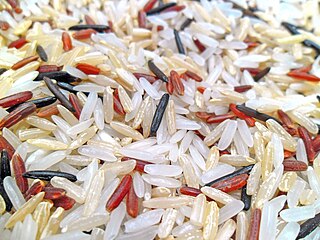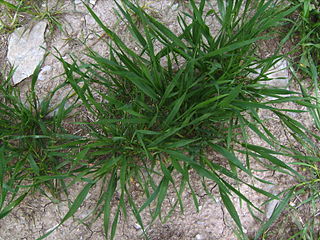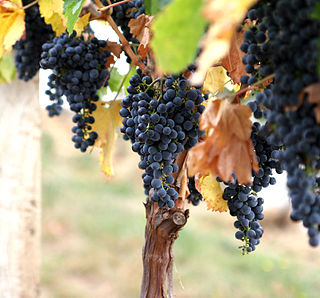The BBCH-scale (rice) identifies the phenological development stages of rice Oryza sativa. It is a plant species specific version of the BBCH-scale.

Phenology is the study of periodic plant and animal life cycle events and how these are influenced by seasonal and interannual variations in climate, as well as habitat factors. The word, coined by the Belgian botanist Charles Morren around 1849, is derived from the Greek φαίνω (phainō), "to show, to bring to light, make to appear" + λόγος (logos), amongst others "study, discourse, reasoning" and indicates that phenology has been principally concerned with the dates of first occurrence of biological events in their annual cycle. Examples include the date of emergence of leaves and flowers, the first flight of butterflies and the first appearance of migratory birds, the date of leaf colouring and fall in deciduous trees, the dates of egg-laying of birds and amphibia, or the timing of the developmental cycles of temperate-zone honey bee colonies. In the scientific literature on ecology, the term is used more generally to indicate the time frame for any seasonal biological phenomena, including the dates of last appearance.

Rice is the seed of the grass species Oryza sativa or Oryza glaberrima. As a cereal grain, it is the most widely consumed staple food for a large part of the world's human population, especially in Asia. It is the agricultural commodity with the third-highest worldwide production, after sugarcane and maize.
The BBCH-scale is used to identify the phenological development stages of plants. BBCH-scales have been developed for a range of crop species where similar growth stages of each plant are given the same code.
| Growth stage | Code | Description |
|---|---|---|
| 0: Germination | 00 | Dry seed (caryopsis) |
| 01 | Beginning of seed imbibition | |
| 03 | Seed imbibition complete (pigeon breast) | |
| 05 | Radicle emerged from caryopsis | |
| 06 | Radicle elongated, root hairs and/or side roots visible | |
| 07 | Coleoptile emerged from caryopsis (in water-rice this stage occurs before stage 05) | |
| 09 | Imperfect leaf emerges (still rolled) at the tip of the coleoptile | |
| 1: Leaf development1, 2 | 10 | Imperfect leaf unrolled, tip of first true leaf visible |
| 11 | First leaf unfolded | |
| 12 | 2 leaves unfolded | |
| 13 | 3 leaves unfolded | |
| 1 . | Stages continuous till . . . | |
| 19 | 9 or more leaves unfolded | |
| 2: Tillering3 | 21 | Beginning of tillering: first tiller detectable |
| 22 | 2 tillers detectable | |
| 23 | 3 tillers detectable | |
| 2 . | Stages continuous till ... | |
| 29 | Maximum number of tillers detectable | |
| 3: Stem elongation3 | 30 | Panicle initiation or green ring stage: chlorophyll accumulates in the stem tissue, forming a green ring |
| 32 | Panicle formation: panicle 1–2 mm in length | |
| 34 | Internode elongation or jointing stage: internodes begin to elongate, panicle more than 2 mm long (variety-dependent) | |
| 37 | Flag leaf just visible, still rolled, panicle moving upwards | |
| 39 | Flag leaf stage: flag leaf unfolded, collar regions (auricle and ligule) of flag leaf and penultimate leaf aligned (pre-boot stage) | |
| 4: Booting | 41 | Early boot stage: upper part of stem slightly thickened, sheath of flag leaf about 5 cm out of penultimate leaf sheath |
| 43 | Mid boot stage: sheath of flag leaf 5–10 cm out of the penultimate leaf sheath | |
| 45 | Late boot stage: flag leaf sheath swollen, sheath of flag leaf more than 10 cm out of penultimate leaf sheath | |
| 47 | Flag leaf sheath opening | |
| 49 | Flag leaf sheath open | |
| 5: Inflorescence emergence, heading4 | 51 | Beginning of panicle emergence: tip of inflorescence emerged from sheath |
| 52 | 20% of panicle emerged | |
| 53 | 30% of panicle emerged | |
| 54 | 40% of panicle emerged | |
| 55 | Middle of panicle emergence: neck node still in sheath | |
| 56 | 60% of panicle emerged | |
| 57 | 70% of panicle emerged | |
| 58 | 80% of panicle emerged | |
| 59 | End of panicle emergence: neck node level with the flag leaf auricle, anthers not yet visible | |
| 6: Flowering, anthesis | 61 | Beginning of flowering: anthers visible at top of panicle |
| 65 | Full flowering: anthers visible on most spikelets | |
| 69 | End of flowering: all spikelets have completed flowering but some dehydrated anthers may remain | |
| 7: Development of fruit | 71 | Watery ripe: first grains have reached half their final size |
| 73 | Early milk | |
| 75 | Medium milk: grain content milky | |
| 77 | Late milk | |
| 8: Ripening | 83 | Early dough |
| 85 | Soft dough: grain content soft but dry, fingernail impression not held, grains and glumes still green | |
| 87 | Hard dough: grain content solid, fingernail impression held | |
| 89 | Fully ripe: grain hard, difficult to divide with thumbnail | |
| 9: Senescence | 92 | Over-ripe: grain very hard, cannot be dented by thumbnail |
| 97 | Plant dead and collapsing | |
| 99 | Harvested product |
1 A leaf is unfolded when its ligule is visible or the tip of the next leaf is visible
2 Tillering or stem elongation may occur earlier than stage 13; in this case continue with stages 21 or 30
3 If stem elongation begins before the end of tillering continue with stage 30
4 Flowering usually starts before stage 55; continue with principal stage 6




